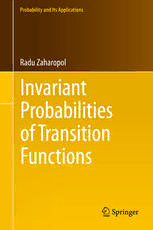Table Of ContentProbability and Its Applications
Radu Zaharopol
Invariant
Probabilities
of Transition
Functions
Probability and Its Applications
PublishedinassociationwiththeAppliedProbabilityTrust
Editors:S. Asmussen,J. Gani,P. Jagers,T.G. Kurtz
Probability and Its Applications
TheProbabilityandItsApplicationsseriespublishesresearchmonographs,withtheexpos-
itory quality to make them useful and accessible to advanced students, in probability and
stochasticprocesses,withaparticularfocuson:
– FoundationsofprobabilityincludingstochasticanalysisandMarkovandotherstochastic
processes
– Applicationsofprobabilityinanalysis
– Pointprocesses,randomsets,andotherspatialmodels
– Branchingprocessesandothermodelsofpopulationgrowth
– Geneticsandotherstochasticmodelsinbiology
– Informationtheoryandsignalprocessing
– Communicationnetworks
– Stochasticmodelsinoperationsresearch
Forfurthervolumes:
http://www.springer.com/series/1560
Radu Zaharopol
Invariant Probabilities
of Transition Functions
123
RaduZaharopol
AnnArbor
Michigan
USA
ISSN1431-7028 ProbabilityandItsApplications
ISBN978-3-319-05722-4 ISBN978-3-319-05723-1(eBook)
DOI10.1007/978-3-319-05723-1
SpringerChamHeidelbergNewYorkDordrechtLondon
LibraryofCongressControlNumber:2014942551
MathematicsSubjectClassification(2010):47A35,37A30,37A17,60J25,37A50,37A10,28D10
(cid:2)c SpringerInternationalPublishingSwitzerland2014
Thisworkissubjecttocopyright.AllrightsarereservedbythePublisher,whetherthewholeorpartof
thematerialisconcerned,specificallytherightsoftranslation,reprinting,reuseofillustrations,recitation,
broadcasting,reproductiononmicrofilmsorinanyotherphysicalway,andtransmissionorinformation
storageandretrieval,electronicadaptation,computersoftware,orbysimilarordissimilarmethodology
nowknownorhereafterdeveloped.Exemptedfromthislegalreservationarebriefexcerptsinconnection
with reviews or scholarly analysis or material supplied specifically for the purpose of being entered
and executed on a computer system, for exclusive use by the purchaser of the work. Duplication of
this publication or parts thereof is permitted only under the provisions of the Copyright Law of the
Publisher’slocation,initscurrentversion,andpermissionforusemustalwaysbeobtainedfromSpringer.
PermissionsforusemaybeobtainedthroughRightsLinkattheCopyrightClearanceCenter.Violations
areliabletoprosecutionundertherespectiveCopyrightLaw.
Theuseofgeneraldescriptivenames,registerednames,trademarks,servicemarks,etc.inthispublication
doesnotimply,evenintheabsenceofaspecificstatement,thatsuchnamesareexemptfromtherelevant
protectivelawsandregulationsandthereforefreeforgeneraluse.
While the advice and information in this book are believed to be true and accurate at the date of
publication,neithertheauthorsnortheeditorsnorthepublishercanacceptanylegalresponsibilityfor
anyerrorsoromissionsthatmaybemade.Thepublishermakesnowarranty,expressorimplied,with
respecttothematerialcontainedherein.
Printedonacid-freepaper
SpringerispartofSpringerScience+BusinessMedia(www.springer.com)
DedicatedtoMarinaand Daniel,
andtothememoryofmymother andmy
father
Acknowledgements
It is a great pleasure to acknowledge the various kinds of support that I received
fromthefollowingpeople:EduardEmel’yanovshowedinterestinbothmymono-
graph [143] and this book by making a series of useful comments including the
improvementin the Lasota-Yorke lemma that appears in Theorem 1.2.3; Thomas
Hempflinghasshowninterestinthemonographandhasofferedmeexpertguidance
throughoutthepublicationprocess;MariusIosifescuhasalwaysbeenavailablefor
ème
extremelyusefuladvice;healsoinvitedmetothe9 ColloqueFranco-Roumain
deMath.Appl.,28Août-2Septembre2008,Bras¸ov,Romania,togiveatalkonsome
ofthetopicsdiscussedhere;MarinaReizakisandherteamatSpringerhaveexpertly
prepared the book for publication; Daniel W. Stroock brought to my attention
informationconcerningergodicmeasuresthatappearin hisbooks[119] and[29];
Tomasz Szarek sent me several of his works that I have used here; Daniël Worm
showedgreatinterestintheresultsontheKBBY decompositionthatIobtainedin
this bookand elsewhere (as I pointout several times, he has extendedthe KBBY
decomposition to Polish spaces and has obtained various other very interesting
resultsrelated to the decomposition);andlastly Marina Zaharopolhas offeredme
veryusefuladvice.
vii
Contents
1 PreliminariesonTransitionProbabilities................................. 1
1.1 BasicDefinitionsandResults.......................................... 2
1.2 InvariantProbabilities.................................................. 20
1.3 TheErgodicDecompositionofKryloff,Bogoliouboff,
BeboutoffandYosida .................................................. 25
1.4 FellerTransitionProbabilities ......................................... 36
1.4.1 SupportsofElementaryandErgodicInvariant
Measures, Minimality,Unique Ergodicity,
andGenericPoints............................................. 36
1.4.2 Equicontinuity................................................. 45
2 PreliminariesonTransitionFunctionsandTheirInvariant
Probabilities .................................................................. 57
2.1 TransitionFunctions.................................................... 57
2.2 Examples................................................................ 68
2.2.1 TransitionFunctionsDefinedbyOne-Parameter
SemigroupsorGroupsofMeasurableFunctions:
GeneralConsiderations........................................ 69
2.2.2 Transition Functions Defined by Specific
One-Parameter Semigroups or Groups
ofMeasurableFunctions...................................... 72
2.2.3 TransitionFunctionsDefinedbyOne-Parameter
ConvolutionSemigroupsofProbabilityMeasures........... 83
2.3 InvariantProbabilityMeasures ........................................ 89
3 PreliminariesonVectorIntegralsandAlmostEverywhere
Convergence.................................................................. 97
3.1 TheBochnerandtheDunford-SchwartzIntegrals.................... 97
3.1.1 TheBochnerIntegral.......................................... 98
3.1.2 CompleteMeasureSpaces .................................... 102
3.1.3 TheDunford-SchwartzIntegral............................... 105
ix

